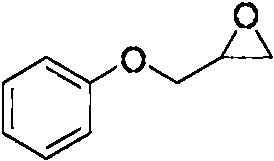Synthesis method of 1-arylacetylene seleno-3-phenoxy-2-propanol compound
A synthesis method and phenoxy technology, applied in the field of organic compound synthesis, can solve the problems of pre-preparation, narrow substrate range, poor functional group tolerance, etc., and achieve the effects of simple post-processing, high yield and purity, and high yield
- Summary
- Abstract
- Description
- Claims
- Application Information
AI Technical Summary
Problems solved by technology
Method used
Image
Examples
Embodiment 1
[0031] Synthesis of 1-(4-methylphenylacetylene selenyl)-3-phenoxy-2-propanol
[0032]
[0033] At room temperature, 4-methylphenylpropynoic acid (0.2mmol), elemental selenium (0.6mmol), phenyl glycidyl ether (0.6mmol), copper chloride (0.02mmol), 1,10-phenanthro Phenyl (0.02mmol), cesium carbonate (0.6mmol), tetrabutylammonium iodide (0.4mmol) and 2mL water were stirred at a reaction temperature of 50°C for 24h. After the reaction is over, add ethyl acetate to dilute, transfer the diluted solution to a separatory funnel for extraction, separate the aqueous phase and the organic phase, then extract the aqueous phase with ethyl acetate for 3 times, combine the organic phases, and add 5g of anhydrous sulfuric acid Sodium, stand still for 30min, wash the filter cake 3 times with 5mL ethyl acetate each time, then spin off the solvent, and obtain the product through column chromatography (eluent: sherwood oil: ethyl acetate=20: 1), the product is Light yellow solid with a meltin...
Embodiment 2
[0041] Synthesis of 1-(2,4,6-trimethylphenylethynylselenyl)-3-phenoxy-2-propanol
[0042]
[0043]At room temperature, 2,4,6-trimethylphenylpropynoic acid (0.2mmol), elemental selenium (0.6mmol), phenyl glycidyl ether (0.6mmol), copper chloride (0.02mmol), 1, 10-Phenanthroline (0.02mmol), cesium carbonate (0.6mmol), tetrabutylammonium iodide (0.4mmol) and 2mL water were stirred at a reaction temperature of 50°C for 24h. After the reaction is over, add ethyl acetate to dilute, transfer the diluted solution to a separatory funnel for extraction, separate the aqueous phase and the organic phase, then extract the aqueous phase with ethyl acetate for 3 times, combine the organic phases, and add 5g of anhydrous sulfuric acid Sodium, stand still for 30min, wash the filter cake 3 times with 5mL ethyl acetate each time, then spin off the solvent, and obtain the product through column chromatography (eluent: sherwood oil: ethyl acetate=20: 1), the product is Pale yellow liquid, yiel...
Embodiment 3
[0051] Synthesis of 1-(4-methoxyphenylacetylene selenyl)-3-phenoxy-2-propanol compound
[0052]
[0053] At room temperature, 4-methoxyphenylpropynoic acid (0.2mmol), elemental selenium (0.6mmol), phenyl glycidyl ether (0.6mmol), copper chloride (0.02mmol), 1,10-phenanthrene Roline (0.02mmol), cesium carbonate (0.6mmol), tetrabutylammonium iodide (0.4mmol) and 2mL water were stirred at a reaction temperature of 50°C for 24h. After the reaction is over, add ethyl acetate to dilute, transfer the diluted solution to a separatory funnel for extraction, separate the aqueous phase and the organic phase, then extract the aqueous phase with ethyl acetate for 3 times, combine the organic phases, and add 5g of anhydrous sulfuric acid Sodium, stand still for 30min, wash the filter cake 3 times with 5mL ethyl acetate each time, then spin off the solvent, and obtain the product through column chromatography (eluent: sherwood oil: ethyl acetate=20: 1), the product is Light yellow solid ...
PUM
 Login to View More
Login to View More Abstract
Description
Claims
Application Information
 Login to View More
Login to View More - R&D
- Intellectual Property
- Life Sciences
- Materials
- Tech Scout
- Unparalleled Data Quality
- Higher Quality Content
- 60% Fewer Hallucinations
Browse by: Latest US Patents, China's latest patents, Technical Efficacy Thesaurus, Application Domain, Technology Topic, Popular Technical Reports.
© 2025 PatSnap. All rights reserved.Legal|Privacy policy|Modern Slavery Act Transparency Statement|Sitemap|About US| Contact US: help@patsnap.com



